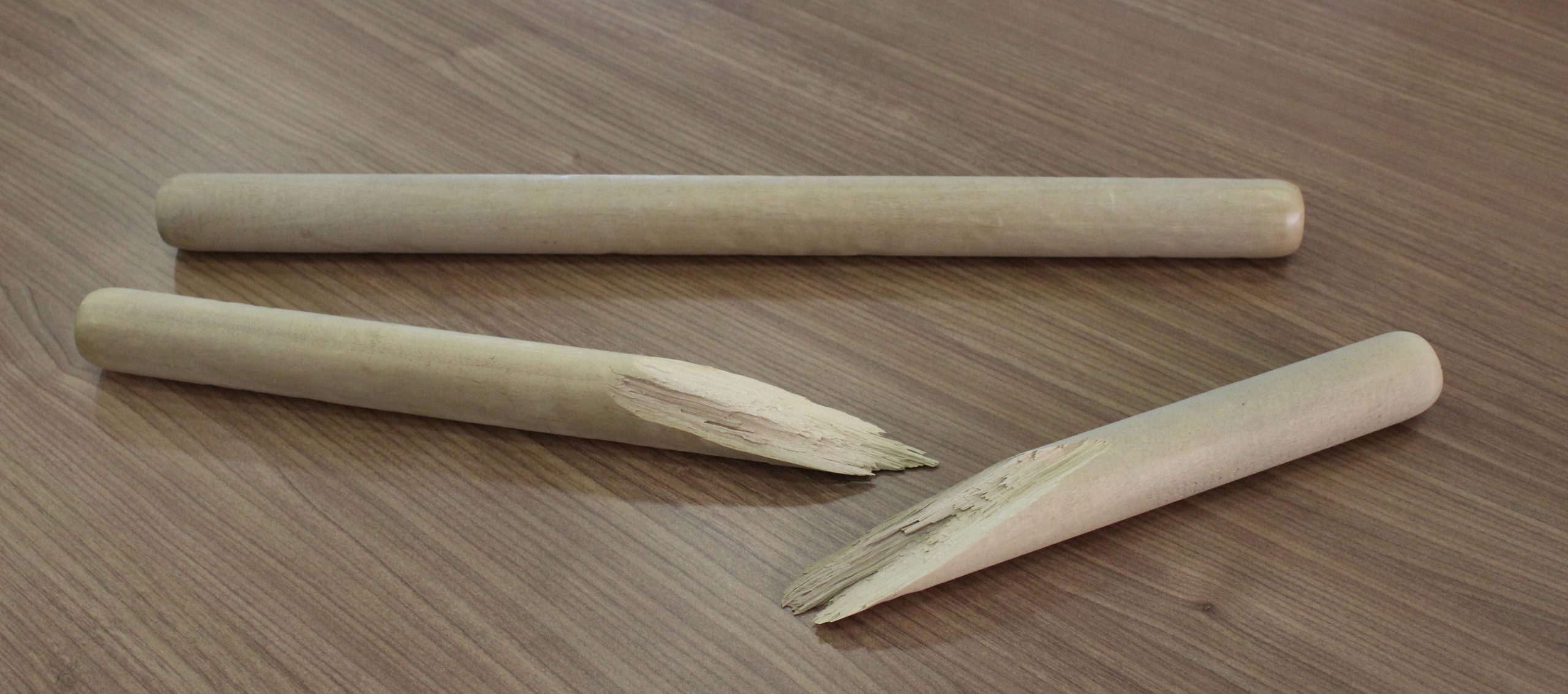https://viewshape.com/shapes/a652ac9233c6
About the instrument
In Japanese taiko drumming, wooden sticks called bachi are used to hit the head of the drum. Taiko drums come in various sizes from the small, high-pitched shime-daiko, to the mid-sized chu-daiko, to the large, lower-pitched o-daiko, and each of these requires a different size of bachi. Bachi range in diameter, length, and shape, and are carved from different kinds of wood, including oak, maple, magnolia, and cypress. The bachi on display here are about 1.5 inches in diameter and 19.5 inches long, slightly larger than the most common size, about 7/8-inch in diameter and about 1

6 inches long. Made of magnolia wood, a lighter wood than the typical cypress, this pair is easier to swing, and its larger size allows for a bigger sound when striking the drum.
Taiko drums can be traced back to 8th-century gagaku, Japan’s imperial court music, as well as noh and kabuki styles of Japanese theatre. Taiko drumming also features predominantly in traditional festivals throughout the year, such as the Buddhist Obon festival. Kumi daiko, or ensemble drumming, is a relatively new practice, originating in Japan in the 1950s and appearing in the United States in the late 1960s. Weselyan’s Beginner and Advanced Taiko classes practice this style of drumming.
Becoming broken: how and why?
Bachi can withstand a lot of force, but a hit at the wrong angle or wrong part of the drum can cause the wood to crack. This pair of bachi on display broke in half during a rehearsal, after a misplaced hit on the rim instead of the head of the chu-daiko. Eli Epstein-Lubow, a Wesleyan sophomore and member of Weselyan’s Advanced Taiko Ensemble, describes what happened: “Instead of hitting the middle part of the drum where you’re supposed to hit, … the bachi hit the rim of the drum really hard, and that made it snap in half basically. … I felt it happen, but it didn’t actually break. … Then I hit it again and the half just shot across the room. … I was just standing there, holding half of [the bachi] in my hand.” On the unbroken bachi, we can see slight indentations in the wood where misdirected hits may have dented the exterior, but not caused any structural damage. The split bachi reveals the grain of the wood running parallel to the length of the stick, and any force applied at an angle to this grain will be more likely to cause damage.
Bachi don’t often break this dramatically, however, and Wesleyan’s Taiko instructor Fumi Tanakadate explained to me that the most frequent instances of bachi damage come from environmental effects. Low humidity can cause the wood to form small cracks and splinters, which often happens with smaller, thinner bachi used for shime-daiko. Professor Tanakadate also explained that in her professional taiko playing, performers often take measures to prevent or anticipate breaking bachi. At the studio in New York where she teaches, the drumheads are covered in thick rubber pads, protecting both the drumhead and the bachi in the case of a misdirected hit. In concerts, performers generally have an extra pair of bachi close at hand, in the event that one is dropped or cracked.

Repair or retire?
In general, bachi are more often replaced than repaired. Bachi can range in price from $20 to $40 and are mass produced, so they do not carry as much monetary or craftsmanship value as the drums, for example, which are hand-made and can take years to make. Small repairs such as wrapping tape around the bachi can help keep splinters from worsening, but this affects their aesthetic and feel. A player’s personal preference will determine whether they decide to tape and extend the life of the bachi or discard it in favor of a new pair. It is nearly impossible to repair a clean fracture, however, and Professor Tanakadate explains that once a bachi is broken, “it’s really easy to break it again,” which could be potentially dangerous for both the player and the drum.
The broken bachi on display was intercepted on its way to the trash and salvaged for the purpose of this exhibit, but it will likely find its way back to the garbage unless it finds another creative use. Professor Tanakadate recalls that one of her taiko instructors once suggested making a bonfire with a collection of broken bachi that he had accumulated over the years, as a more exciting and perhaps dignified method of disposal, but this is not a common practice. Bachi, as well as broken drum skins, are also sometimes signed by performers and saved as souvenirs or given as gifts.
-Devanney Haruta, MA candidate in Ethnomusicology
Click here to see a video of the Wesleyan Taiko Ensemble in concert.
Click here to see an interactive 3D scan of this object.
Sources:
Bender, Shawn. Taiko Boom: Japanese Drumming in Place and Motion. Berkeley: University of California Press, 2012.
Ferranti, Hugh de, Shigeo Kishibe, David W. Hughes, et. al. “Japan.” Grove Music Online. 2001; Accessed 23 Mar. 2021. https://doi-org.ezproxy.wesleyan.edu/10.1093/gmo/9781561592630.article.43335
Yoon, Paul J. “Taiko.” Grove Music Online. 31 Jan. 2014; Accessed 23 Mar. 2021. https://doi-org.ezproxy.wesleyan.edu/10.1093/gmo/9781561592630.article.A2258383
Interviews:
Fumi Tanakadate
Eli Epstein-Lubow
While Wesleyan’s campus is closed to the general public due to Covid restrictions, we welcome all visitors to explore this virtual exhibit. Please click on the links below to see other posts:


